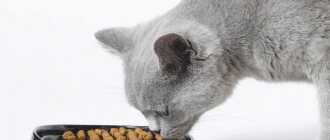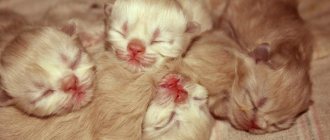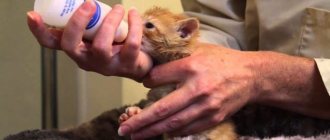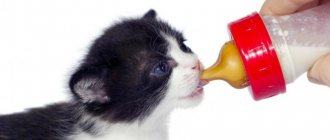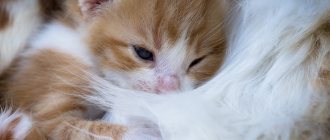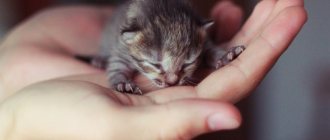Over the next months, the number of feedings is increased to 3 times a day. Milk is offered up to six months, after which it is not recommended, since the body of maturing animals reacts poorly to lactose. It is also necessary to ensure that there is always water in the bowl to quench your thirst.
After one and a half months, the kitten’s need for protein foods – meat, fish, eggs – increases. In any case, the diet should be balanced and contain the substances and microelements necessary for the development of fluffy fur.
What is better – natural food or dry food?
The debate about what is healthier – ready-made food or natural food – continues unabated. Dry granules and pates come to the rescue when the owner does not have time to prepare complex and healthy recipes. In addition, industrial feeds undergo a number of tests, so the composition of the product, if not ideal (preservatives, thickeners, etc. are present), is then balanced. Feeding natural foods also has a number of advantages:
- well absorbed by the animal’s body;
- is as close as possible to the natural needs of carnivorous predators;
- does not contain ingredients harmful to cats - salt, sugar and others.
The only negative is that you need to prepare food for the cat separately, since adding seasonings and spices for taste is unacceptable. In addition, you need to regularly give vitamin complexes.
Vitamins
Natural cat milk contains all the vitamins a kitten needs. But artificial mixtures are not always able to satisfy all the needs of a growing organism. A lack of vitamins, in turn, can lead to vitamin deficiency, which, in turn, leads to decreased activity, loss of animal beauty and vulnerability to infectious diseases.
That is why the owner should carefully ensure that all the necessary microelements enter the body of small pets.
Particularly important vitamins are:
- A-group. These vitamins are necessary to maintain immunity, cell renewal and growth, and normal vision;
- B vitamins influence almost all vital processes. They are needed for the good functioning of the gastrointestinal tract, nervous system, musculoskeletal system, vascular and heart function, as well as the development of muscle tissue;
- Vitamin C takes an active part in metabolism, stimulates the immune system, helps the absorption of various mineral compounds, and helps ensure the body’s protective functions;
- Vitamin D promotes the absorption of phosphorus and calcium. This microelement is simply necessary for the normal growth of teeth, claws and bones;
- Vitamin E is an antioxidant that fights free radicals. Also, this substance plays an important role in the formation and development of the reproductive system;
- K is a vitamin responsible for blood clotting and the process of hematopoiesis.
When can you switch to dry food and how to do it correctly?
When feeding a kitten older than a month, you should give preference to industrially produced wet food: pates, sauces, etc. They choose by carefully reading the labels on the packages - it always indicates what age the product is intended for. When feeding natural food, the food is ground for up to a month, and then the meat is cut or minced, asking the pet to cope with large pieces.
After 1.5-2 months, your pet can be offered dry granules. Only first they are soaked in milk (goat milk or milk substitute), plain water and left in a bowl. If the baby easily copes with this type of food, then some of the granules are soaked and mixed with dry ones (no more than 20% of the serving volume on the first day). If the kitten has no visible digestive problems, the percentage of dry food is increased every couple of days, transferring the animal completely to dry food.
You cannot feed not only a kitten, but also an adult cat (feline) only dry food! This can lead to bowel problems and dehydration. It is recommended to alternate dry and wet types of food, then the diet will be closer to balanced.
Feeding with ready-made formulas
global $ads_google;
//data-ad-slot=”2475549904″ $ads_google = empty($ads_google) ? false : true; ?> if ($ads_google == false) {?> $ads_google = true; ?> } ?> If you need to feed a kitten from its very birth, then you need to know what such babies are fed. Many people wonder whether it is possible to feed newborn kittens with infant formula or whether they will have to buy only specialized ready-made formulas.
If the situation is extreme, and there is baby formula in the house, then it can be diluted in a 1:2 ratio with water. Baby food formulas for the digestive system of kittens are too fatty and rich in micro- and macroelements. Diluted with water in the right proportion, they become less concentrated and heavy for the kitten’s stomach.
Cat milk substitutes have long been developed and sold in veterinary pharmacies. The milk of other animals is less suitable and can easily upset the animal's stomach.
Feeding formulas can be purchased in both liquid and powder form. The digestion of cat babies functions normally, the intestinal microflora is in perfect order.
Types of dry food for kittens
All finished products, which are offered by various manufacturers, are divided into classes. Each has both pros and cons.
Economy class food
These are the brands that constantly appear in advertising and are presented in a wide range on the shelves of any supermarket: Kitikat, Whiskas, Sheba and others. The products of the listed brands are affordable, but the composition is not always up to par. Disadvantages include:
- low meat content;
- the presence of various taste stabilizers, thickeners, etc.;
- the presence of cereals harmful to the cat’s body, for example, corn.
But the variety of different flavors and textures, combined with low prices, is helping to popularize inexpensive brands. In order not to treat your beloved pet later, it is better to avoid economy-class food or give it very rarely.
Premium products
This class includes the brands “Hills”, “ProPlan”, “Akana”, “Royal Konin”. The composition contains a higher percentage of pure meat, grains and vegetables. The food is enriched with vitamin and mineral complexes and is suitable for a complete daily diet. There are specialized lines for small kittens, spayed and neutered, as well as older animals. The cost is higher compared to economy segment products. When buying such food, the owner can be sure that the cat will not only be well fed, but will not “earn” sores.
Holistic
These are products of the highest quality, containing only natural meat without processed products. The manufacturer guarantees that the animals are raised in excellent conditions and are fed only healthy food. The finished products do not contain chemical additives, GMOs, soy, or corn. The cost of food in the holistic segment is very affordable.
A small kitten needs tireless care and frequent feeding. This is especially important if the pet was left without maternal affection at an early age. Organizing care is difficult, but quite possible. The feeding schedule changes as the baby grows and is 8-10 times in the first 2 weeks of life; 7-8 times a month; 6-7 – at two months; 5 servings per day at 3-4 months and 2-3 for adolescents and adult animals. Newborns and toddlers are fed only milk (goat's milk) or milk substitute. Older adults require more food, so complementary foods are introduced from 1.5 months. For full development, a kitten needs a balanced diet, so you can either buy ready-made (dry and wet) food, or diversify natural food. Whether your pet will be healthy, cheerful and active directly depends on the quality of food, which the owner must take care of!
Feeding Basics for Newborn Kittens
global $ads_google;
//data-ad-slot=”2475549904″ $ads_google = empty($ads_google) ? false : true; ?> if ($ads_google == false) {?> $ads_google = true; ?> } ?> If a cat does not feed newborn kittens , then the owner will have to become the mother.
To prevent the process from causing inconvenience, sit down comfortably and place a diaper on your knees. The cub is placed on the prepared bedding - it should lie as if it were being fed by a mother cat. If it is a newborn, then he is placed lying down and his head is raised slightly. It is important to ensure that your head is not thrown back excessively!
After placing the baby, they begin the feeding process itself.
Feeding methods
If you had to replace the furry mother, you need to know how to feed newborn kittens without a cat. First use a pipette or syringe. Although you can find specialized nipples and bottles in pet stores.
A drop of milk is squeezed out of the pipette and the crumbs are brought to the spout. As soon as the baby smells the milky aroma, he begins to look for the nipple. It is at this time that the new “mother” puts a syringe or pipette with milk mixture into his mouth. The main thing is not to swallow a lot of air, which can lead to abdominal pain.
Feeding diet for a newborn kitten
If feeding the kitten falls entirely on the shoulders of a person, then you need to take into account the laboriousness of the process and regularly allocate time for this. If there is no nurse cat nearby who would agree to take other people’s babies under her wing, then you need to think about the most suitable replacement for cat’s mother’s milk.
Together with mother's milk, kittens receive immunity, minerals and vitamins. A suitable mixture can be a replacement. You can buy it at a pet store or prepare it yourself. It is not advisable to heat the mixture in the microwave; it is better to heat it in a water bath until warm. Before giving the cat something to eat, they try to leave a drop of milk on their wrist so that the cub doesn’t get burned. In the first two weeks, the food temperature should correspond to the baby’s body temperature.
At the end of the newborn period, complementary foods consisting of formula and milk porridge begin to be introduced. Starting from day 21, it is useful to diversify the menu with low-fat cottage cheese, baby meat food, egg yolk, fish and lean beef. Starting from day 35, kittens are quite capable of eating from a bowl.
What should you not feed your kitten?
There are foods that should not be given to a cat. Their consumption leads to acute and chronic diseases of the gastrointestinal tract and genitourinary system. For small kittens and adult cats, this list is approximately the same:
- fried, salty and fatty foods,
- meat with bones,
- sweets and chocolate,
- whole cow's milk,
- raisins and grapes,
- sausage and canned food from your table,
- smoked meats,
- baking,
- legumes (only in very limited quantities, for example, as part of a balanced ready-made feed),
- potato,
- River fish.
Growth stages and needs of kittens from 0 to 30 days
In the first month, kittens experience processes of growth and development of the body; proper care during this period allows them to improve their health and avoid diseases in the future.
- The neonatal period lasts from the day the baby is born until 10 days. At this time, rapid noticeable changes in internal organs and external signs occur. Newborn kittens navigate thanks to two sensory systems - tactile and olfactory, since their eyes are closed and the auditory canal is not fully formed. Babies spend most of their time sleeping. Around the fifth day, the kitten begins to hear.
- The transitional stage begins at day 10 and lasts until day 20. At this time, kittens open their eyes, which means the central nervous system is maturing. It is believed that this stage is favorable for establishing good contact between the owner and the pet. Veterinarians recommend teaching your baby to hold hands. From the 10th day, the time spent with the owner should be about 4 minutes; as they grow older, the duration reaches 40 minutes a day. Regular communication with your pet is the key to a friendly relationship.
- The socialization stage begins when the baby takes his first steps. From this moment on, it is easier for the kitten to learn about the world around him. At the same time, the formation of the nervous system, adaptation mechanisms and socialization occurs.
Rules for feeding a newborn kitten without a cat
For the proper growth and development of a kitten, its feeding regimen, which depends on age, is of great importance. A person who picks up a baby on the street will have to navigate by the following signs:
- the presence of an umbilical cord - the kitten is less than 3 days old, since it is at this time that it disappears;
If the kitten's umbilical cord has not fallen off, it is less than three days old
- eyes: closed - he is less than a week old;
- open, but the palpebral fissure is still narrowed - the kitten is 2-3 weeks old;
- change of eye color from blue to green - age 6-7 weeks, but if the kitten is a blue-eyed breed, there will be no change in eye color;
- seem very small, pressed to the head - he is less than one week old;
- kittens in the first week of life weigh 100–150 g;
- no teeth - the kitten is less than 2 weeks old;
- uncertainty and staggering when walking - the kitten is about 2 weeks old;
Sometimes the age of a kitten can only be determined approximately
Feeding mode
Compliance with the feeding regime is vital for small kittens deprived of mother's milk and care:
- the first week of a kitten’s life is fed every 2 hours;
- the second week - every 3-4 hours;
- third week - 6 times a day;
- Until the age of 2 months, the kitten continues to be fed 6 times a day, switching to 5 meals a day at 2 months.
Calculation of the required amount of formula for feeding
When preparing and feeding the mixture, you should be guided by the annotation that the manufacturer attaches to its product, but an average calculation can be given:
- Determination of daily requirement: Age 1 week - 30 ml per 100 g of kitten weight.
- Age 2 weeks - 35 ml per 100 g of kitten weight.
- Age 3 weeks - 40 ml per 100 g of kitten weight.
- Age 4 weeks - 48–53 ml per 100 g of kitten’s body weight.
An important criterion for assessing the effectiveness of feeding is the kitten’s well-being:
- the kitten looks dense;
- The kitten’s behavior is calm, it does not squeak between feedings;
- gains 10 g of weight every day;
- decorated chair, light brown;
- mucous membranes are moist and pink.
When do kittens need artificial feeding?
The ideal situation is as follows: the cat cares for and feeds the kitten until it is approximately 8 weeks old. Only then can you separate the baby from his mother. But there are times when human intervention and help is required. Reasons why this may happen include:
- death of a cat;
- lack or deficiency of milk in her;
- mastitis and inflammation of the uterus in a cat;
- eclampsia in a cat, that is, calcium deficiency;
- psycho-emotional deviations of the animal.
Sometimes the mother feeds the kittens regularly, but the babies still need complementary foods. This situation may arise if the litter is very large. It happens that a weak kitten is born, which quickly gets tired when sucking - in this case, it also needs additional nutrition. How you manage to feed a kitten without a cat or simply intervene a little in the process will determine its future health.
Kittens weight gain
A kitten's weight gain is an important indicator of its health, growth and development. On average, a kitten should gain 10 g per day; kittens of large breeds (Maine Coon, Norwegian cat and others) can gain 15 g per day.
The kitten should be weighed every day until the age of 2 weeks, from 2 to 4 weeks - once every 3 days, then you can switch to weekly weighing until the end of the kitten's growth period. The weight of a kitten, as well as the rate at which it gains, depends on the expected weight of an adult animal, which is determined by its gender or breed.
Table: kitten body weight depending on its age
| Kitten age | Body mass |
| at birth | 60–160 g |
| 1 Week | 110–260 g |
| 2 weeks | 140–360 g |
| 3 weeks | 200–600 g |
| 4 weeks | 240–750 g |
| 2 months | 400–1700 g |
| 3 months | 1.0–2.5 kg |
| 4 months | 1.7–3.9 kg |
| 5 months | 2.2–5.5 kg |
| 6 months | 2.3–6.0 kg |
| 7 months | 2.4–6.5 kg |
| 8 months | 2.5–6.9 kg |
| 9 months | 2.5–7.0 kg |
| 10 months | 2.5–7.7 kg |
| 11 months | 2.5–8 kg |
| 12 months | 2.5–9 kg |
| Adult animal | 2.5–10 kg |
Dairy products at 1 month
If there is a need to feed a 1-month-old kitten without a cat, then at first he simply needs milk or a milk formula that replaces it. To feed a baby who is 1 month old, you can use boiled cow's milk with the addition of a spoonful of honey per 1 glass of milk. This combination of foods in feeding has a pronounced taste and is very useful, especially for a growing organism.
You can also start feeding a kitten a month with low-fat cream, goat's milk and various fermented milk products, such as yogurt, sour cream, kefir, fermented baked milk, yogurt. He will love this food even as an adult.
© shutterstock
Water
When feeding with formula milk, the body may not need water. When reaching 10-12 days, you should fill the bottle with clean water and offer it to the kitten between feedings. At the age of 15-20 days, you should install a saucer and “show” the kitten the water, lightly pushing it with its muzzle into it. Then nature will take its course.
A source of water must be constantly located so that the animal can drink without obstacles.
Using these tips, you can try to feed a kitten and raise a healthy and strong animal.
Features of feeding cats of different breeds
There are no main differences in food; cats are predators; periodically all breeds are given meat or fish. But there are minor differences: for example, British Shorthairs are fed nutritious food - they grow quickly and need more abundant nutrition. Russian blue cats should not be given liver, and the Maine Coon needs plentiful and dense nutrition (the main thing is not to overfeed).
How to train a kitten to eat on its own
Teaching your baby to eat on his own does not take much time and effort. Already from the 3rd week of life, kittens are actively interested in how their adult relatives eat. At the same time, kittens are of little interest in the contents of the bowl.
First, placing a saucer in front of your pet, you should invite him to “take a sample” of the new food from his finger. He will quickly realize that it is very tasty and will then try to eat the prepositional delicacy from the bowl. Instincts will already tell you how to eat the offered treat.
At first, it’s best to keep an eye on your kitten’s meals. A baby, captivated by a delicious dinner, can get its paws into the bowl, then it is necessary to explain that this cannot be done. In time he will learn manners.
It is better to start the first complementary food for one-month-old kittens with easy-to-digest and liquid foods. If it was decided to feed the kitten natural food, it could be chopped chicken or beef fillet in broth, or liquid porridge. Gradually, the amount of liquid in a serving decreases, teaching you to eat solid food.
If the pet only drinks from the entire portion, but does not eat its portion, the meat can be ground in a blender to a porridge state. Next time he himself will look for pieces of meat in his portion.




